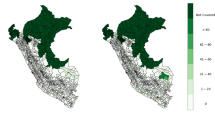Abstract
As a by-product of analysis of state-level prevailing wage laws applying to public construction projects, a strongly inverse correlation was found between black employment and strength of prevailing wage law. Although black construction employment is generally below what it averages in other sectors, it is closer to parity in states where there is no prevailing wage law, and progressively less so in groups of states that have progressively stronger laws.
Similar content being viewed by others
Notes
The seemingly simple intent of prevailing wage laws has proven to be immensely difficult for legislators as well as others to interpret rationally, even in key areas such as providing definition to the word “prevailing.” Those interested in a fuller understanding of the subject should see, inter alia, A. Thieblot, Prevailing Wage Legislation: The Davis-Bacon Act, State “Little Davis-Bacon” Acts, The Walsh-Healy Act, and the Service Contract Act, Labor Relations and Public Policy Series No. 27 (Philadelphia: Wharton Industrial Research Unit, University of Pennsylvania, 1985), pp. 1–43. In application, all prevailing wage laws set minimums based on a variation of a modal rate (the rate paid to the greatest number), provided it is the majority or some other set percentage of the similar craft and class, or base it on the simple or weighted average, or set at the union rate or at a rate found by survey, report, estimation, or assertion to exist in the private construction marketplace. The union rate is frequently found to be prevailing because that is the only rate other than the minimum wage likely to be paid to any significant number of different persons in the same job classification, but only about half of the state laws are likely to set the union rate all the time, and the federal law finds it on about 40–50 percent of individual determinations (already quite a lot, since less than 20 percent of the construction work force is union).
This is the model used by Dr. Philips in “Brazier Constr. Co. v. Reich, No 93-2318 WBB (D.D.C.),” Report of Dr. Peter Philips, Economics Department, University of Utah, January 17, 1996, pp. 82–85.
Dr. Philips claims his model substantiates that blacks in prevailing wage law states receive higher incomes than blacks in non-prevailing wage law states and, therefore, sees benefits to all blacks (regardless of how employed) from prevailing wage laws. But his model makes no measurements of income levels of persons replaced or not employed because of prevailing wage legislation. Furthermore, even assuming the validity of results as presented, one still knows nothing about black employment levels in states that do and do not have prevailing wage laws.
The breakdown of state prevailing wage laws in 1997 shows 9 states that had never had one, 10 states that had repealed their laws after 1979, and one state whose law was inactivated by constitutional problems, leaving 30 active. Additional prevailing wage laws exist in the District of Columbia, in Puerto Rico, Guam and other U.S. territories, and at the local level in a number of states, but we shall not consider those herein.
See A. Thieblot, Stale Prevailing Wage Laws: An Assessment at the Start of 1995 (Rosslyn, Va.: State Relations Department, Associated Builders and Contractors, 1995), p. 1–39.
Details of the analysis are found in A.J. Thieblot, “Prevailing Wage Laws of the States,” summarized on page 18. Positioning was based on a point count of from -1 to 5 in each of five categories, totalling in a range of 2 to 17. The states adjudged to have “weaker” laws were Nebraska (2), Oklahoma (now repealed, 2), Tennessee (2), Kentucky (3), Maine (3), Maryland (4), Montana (4), and Texas (6). “Average” law states were Delaware (7), Connecticut (8), Wyoming (8), New Mexico (9), Arkansas (10), Indiana (10), Pennsylvania (10), Alaska (11), Nevada (11), Oregon (11), West Virginia (11), and Wisconsin (11). States with “stronger” laws were Illinois (12), Missouri (12), Rhode Island (12), Ohio (14), Michigan (now unconstitutional, 14), Minnesota (14), Washington (14), Hawaii (15), California (16), New Jersey (16), New York (16), and Massachusetts (17).
Philips, in “Brazier,” argues (p. 5) that the “supposed inverse correlation between prevailing wage laws and the relative employment of blacks in construction disappears when one excludes from [the] analysis eight southern states with a long history of black involvement in construction,” but in the process of excluding those states he subtracted from the analysis 198,336 of the 203,057 (97.6 percent) blacks employed in construction in states free from prevailing wage laws before concluding, unsurprisingly, that further comparisons in these states did not support the original correlations. Furthermore, one of the eight states he excluded, Florida, has not had any particular history of black involvement in construction, whereas several of those he did not exclude, such as Arkansas or Tennessee, did. In a further attempt to discredit the correlations, Dr. Philips threw out data for all states with over 5 percent black in their work force, then understandably failed to find a relationship between prevailing wage law strength and levels of black employment in the overwhelmingly white areas of the country remaining where there were very few blacks to be influenced one way or another by the laws. (The census found, for example, a total of 18 blacks working in construction in the entire state of Wyoming, 25 in North Dakota, 15 in Vermont, and 6 in Montana. These states he kept in his comparisons as representative, whereas the 38,743 blacks in Florida, the 31,889 in Georgia, and the 34,569 in New York worked in states that were dropped.) This approach reverses the usual statistical practice of concentrating on the main, center portion of a distribution rather than its tails.
Author information
Authors and Affiliations
Rights and permissions
About this article
Cite this article
Thieblot, A.J. Prevailing wage laws and black employment in the construction industry. J Labor Res 20, 155–159 (1999). https://doi.org/10.1007/s12122-999-1031-9
Issue Date:
DOI: https://doi.org/10.1007/s12122-999-1031-9




